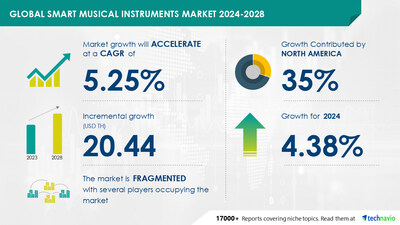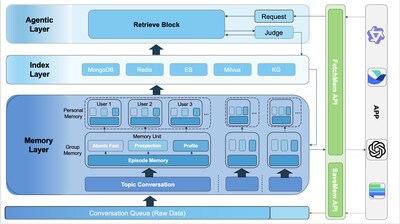Smart Musical Instruments Market size is set to grow by USD 20.43 billion from 2024-2028, Adoption of motion sensors in smart electronics and smart musical instrument, Technavio
Press Releases
May 21, 2024
NEW YORK, May 21, 2024 /PRNewswire/ — The global smart musical instruments market size is estimated to grow by USD 20.43 billion from 2024-2028, according to Technavio. The market is estimated to grow at a CAGR of 5.25% during the forecast period.
For more insights on the forecast market size and historic data (2018 – 2022) – Download Free sample report in a minutes
|
Forecast period |
2024-2028 |
|
Base Year |
2023 |
|
Historic Data |
2018 – 2022 |
|
Segment Covered |
Technology (Connected instruments and |
|
Region Covered |
North America, APAC, Europe, South America, |
|
Key companies profiled |
Artiphon Inc., Audiotonix Ltd., CASIO Computer |
Key Market Trends Fueling Growth
Motion sensors, also referred to as motion detectors, are electronic devices detecting physical movements in real-time. They utilize various technologies like MEMS accelerometers, magnetometers, and gyroscopes, along with microwave, infrared, and ultrasonic sensors. These sensors find wide applications across consumer electronics, aerospace, defense, automotive, and healthcare sectors.
In recent years, their integration into smart devices such as smartphones, smart TVs, and security systems has significantly increased. Moreover, there’s a growing trend in the musical instrument industry towards innovative products. Wearable smart musical instruments, leveraging motion sensors, allow users to create music through body movements or gestures, contributing to market growth.
The increasing adoption of motion sensors in both smart electronics and musical instruments is projected to fuel the global smart musical instruments market. This trend is likely to persist in the forecast period as manufacturers seek to differentiate and enhance their products through technological advancements.
Market Challenges
- Smart musical instruments, distinguished by their advanced technology and durability, command a premium price in the market. While appealing to discerning users seeking innovative features, their high cost dissuades budget-conscious consumers. This pricing gap presents a challenge to the growth of the global smart musical instruments market over the next five years.
- Comparing Yamaha’s offerings illustrates this trend. Traditional pianos are accessible at $700 to $1,100, whereas smart pianos, boasting superior functionality, are priced between $2,200 and $3,000. The significant disparity in cost reinforces the perception of smart instruments as a luxury rather than a necessity.
- Despite their benefits, including enhanced capabilities and prolonged lifespan with minimal upkeep, smart musical instruments face resistance from average buyers due to their prohibitive pricing. This reluctance among mainstream consumers is anticipated to hinder market expansion.
- In conclusion, while smart musical instruments cater to a niche market segment appreciative of their technological advancements, their steep prices present a barrier to widespread adoption, thus limiting market growth prospects in the forecast period.
Research report provides comprehensive data on impact of trend, driver and challenges – Download Free sample report in a minutes
Segment Overview
- Technology
- 1.1 Connected instruments
- 1.2 Wearables
- End-user
- 2.1 Professionals
- 2.2 Hobbyists
- Geography
- 3.1 North America
- 3.2 APAC
- 3.3 Europe
- 3.4 South America
- 3.5 Middle East and Africa
1.1 Connected instruments- The segment for connected musical instruments is expected to experience substantial growth in the coming years. These instruments, which can link to devices like smartphones and laptops via Bluetooth or Wi-Fi, facilitate easier and quicker learning for users.
Valued at USD 55.97 in 2018, this segment offers a range of technologically advanced features such as wireless connectivity, LED light assistance, and audio recording, appealing to both professionals and amateurs. Although currently limited to instruments like piano, keyboard, and guitar, the market is anticipated to see an increase in the availability of connected instruments.
This expansion is projected to drive robust growth in the global smart musical instruments market. With features like portability and multi-task song recording, these instruments meet the needs of a diverse range of users, further contributing to their popularity and market growth.
For more information on market segmentation with geographical analysis including forecast (2024-2028) and historic data (2018 – 2022) – Download a Sample Report
Research Analysis
The music industry is evolving rapidly with technologically advanced instruments offering smart features and seamless integration. From digital advancements to professional performers, connectivity choices like Bluetooth, and mobile devices, the landscape is dynamic. Inbuilt sensors and software enhance composition and performance, while digital audio workstations (DAWs) and music production software empower creators.
Artificial intelligence (AI) algorithms enable intelligent tuning and automatic accompaniment, while responsive feedback improves performance. Educators and producers benefit from adaptable, user-friendly tools merging conventional techniques with smart drums, wind instruments, keyboards, and guitars.
Manufacturers innovate with vintage and sustainable materials like bamboo, recycled metal, and eco-friendly wood. Real-time feedback, effects manipulation, and recording functionality enhance the musician’s experience. Interactive learning systems and online communities foster collaboration and knowledge exchange, while live performances and concerts thrive in virtual spaces.
Raw materials, including wood, steel, and plastic, sustain the production of string instruments, keyboards, recording, and percussion equipment, both online and offline. Social media platforms like Viberate connect musicians globally, shaping the future of music education and performance.
Market Research Overview
AI algorithms empower intelligent tuning and automatic accompaniment, enhancing performance through responsive feedback. Educators and producers gain from versatile, easy-to-use tools merging traditional methods with smart drums, wind instruments, keyboards, and guitars.
Producers pioneer with classic and eco-conscious materials such as bamboo, recycled metal, and sustainable wood. Live feedback, effects control, and recording features elevate the musician’s journey. Interactive educational platforms and online communities encourage collaboration and knowledge sharing, while virtual arenas amplify live shows and performances.
Table of Contents:
1 Executive Summary
2 Market Landscape
3 Market Sizing
4 Historic Market Size
5 Five Forces Analysis
6 Market Segmentation
- Technology
- Connected Instruments
- Wearables
- End-user
- Professionals
- Hobbyists
- Geography
- North America
- APAC
- Europe
- South America
- Middle East And Africa
7 Customer Landscape
8 Geographic Landscape
9 Drivers, Challenges, and Trends
10 Company Landscape
11 Company Analysis
12 Appendix
About Technavio
Technavio is a leading global technology research and advisory company. Their research and analysis focuses on emerging market trends and provides actionable insights to help businesses identify market opportunities and develop effective strategies to optimize their market positions.
With over 500 specialized analysts, Technavio’s report library consists of more than 17,000 reports and counting, covering 800 technologies, spanning across 50 countries. Their client base consists of enterprises of all sizes, including more than 100 Fortune 500 companies. This growing client base relies on Technavio’s comprehensive coverage, extensive research, and actionable market insights to identify opportunities in existing and potential markets and assess their competitive positions within changing market scenarios.
Contacts
Technavio Research
Jesse Maida
Media & Marketing Executive
US: +1 844 364 1100
UK: +44 203 893 3200
Email: [email protected]
Website: www.technavio.com/
![]() View original content to download multimedia:https://www.prnewswire.com/news-releases/smart-musical-instruments-market-size-is-set-to-grow-by-usd-20-43-billion-from-2024-2028–adoption-of-motion-sensors-in-smart-electronics-and-smart-musical-instrument-technavio-302151077.html
View original content to download multimedia:https://www.prnewswire.com/news-releases/smart-musical-instruments-market-size-is-set-to-grow-by-usd-20-43-billion-from-2024-2028–adoption-of-motion-sensors-in-smart-electronics-and-smart-musical-instrument-technavio-302151077.html
SOURCE Technavio





